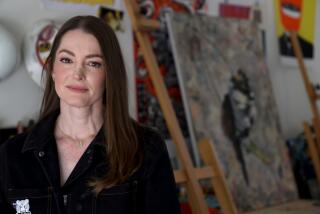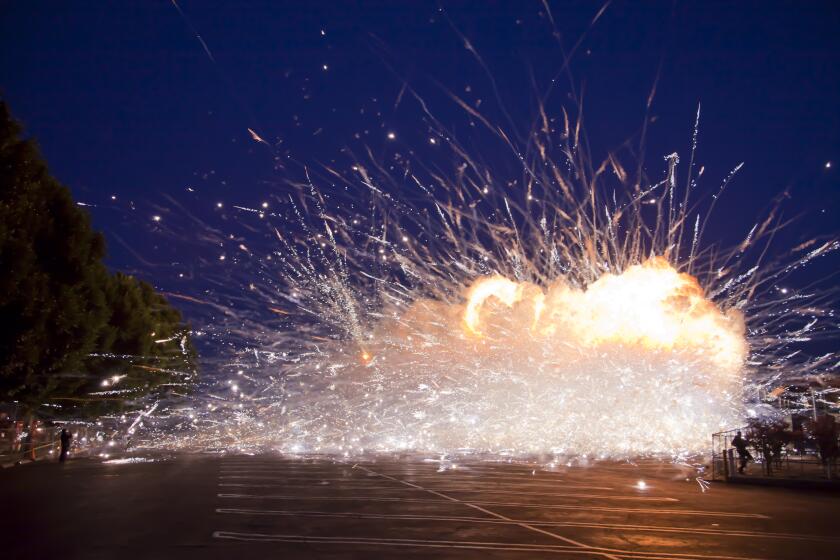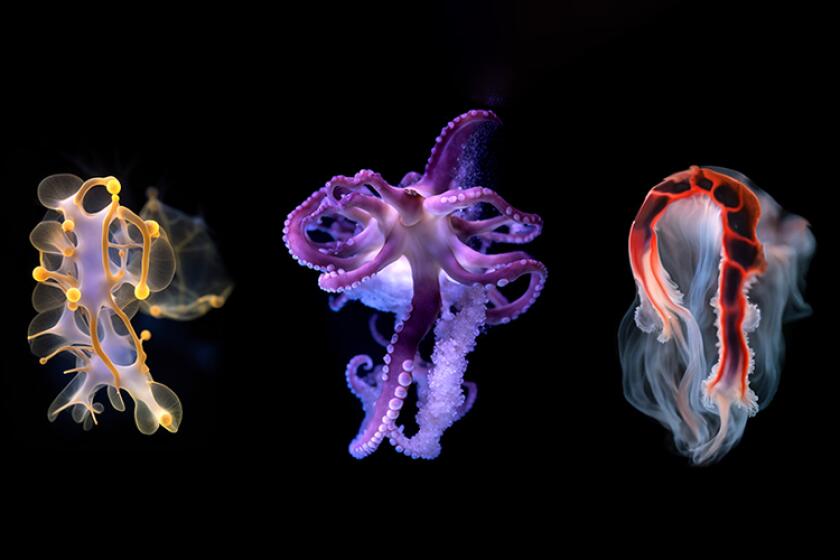ART REVIEW : Reinhardt at MOCA: Only for the Brave
A retrospective of the paintings of linchpin New York abstract artist Ad Reinhardt opened Sunday at the Museum of Contemporary Art. By the laws of predictable paradox, Christo last week launched one of his headline-making land-art projects. The pair make a study in linked contrasts.
Christo’s umbrella project was greeted like pontifical visitation. The Reinhardt survey is liable to attract about as much attention as a Zen monk squatting meditatively in MOCA’s capacious galleries. Modern art, especially of the abstract sort, has long functioned as a kind of surrogate religion.
Ad Reinhardt died in 1967, so we’ll never know what he would have thought of Christo’s art. Chances are he would have disapproved of its sheer scale, beauty and public blandishment. The rest of us can profit from being reminded of that kind of chastity in an art world curdled into everything Reinhardt hated--venal, corrupt, ambitious and more concerned with “relevance” than with quality.
The retrospective is the first any museum has accorded Reinhardt--an artist so seminal that he is claimed by both Minimal and Conceptual schools as a source of innovation. It was jointly organized by MOCA’s director Richard Koshalek and William Rubin, director emeritus of New York’s Museum of Modern Art, where the show appeared earlier this year. It’s a brave gesture by an institution sometimes seen as excessively concerned with entertaining the crowd.
From the work to the catalogue essay, nothing about this exhibition will be easy for the uninitiated. That is at least an authentic reflection of the artist’s intentions. He just wasn’t interested in the attention of anyone unwilling to make a serious effort.
Eighty-odd paintings and collages make up the exhibition. Preponderantly geometric abstractions, all obdurately concern themselves with the fundamentals. Deeply influenced by the grid paintings of Piet Mondrian, Reinhardt examined their visual logic and came up with his version of questions as old as painting itself. Should a painting be compartmentalized or should it look complete from edge-to-edge like an all-over pattern? In the end the artist had it both ways.
Reinhardt groped for his own center like anyone else. Early work muses on Cubism, Abstract Expressionism and purism. Works from the late ‘40s like “Black and White” or “Number 43 (Abstract Painting, Yellow)” are subdued and poetic but from work to work you can see Reinhardt arguing with himself. “Is this too beautiful?” “Does the red bounce off too much?”
Somewhere along the line, he decided on a vocation of renunciation. He started drawing satirical diagrams of the tree of life of the American art world or a primer on how to talk art talk. He wrote broadsides attacking self-expression, Philistines, originality and so much else it seemed there was nothing he approved.
He composed koans like:
Wisdom in art is not wisdom.
Foolishness in art is foolishness.
Consciousness in art is consciousness.
Unconsciousness in art is unconsciousness.
Enigmatic as it all sometimes sounds, it adds up to a picture of a man jettisoning excess baggage. Like a Zen master, Reinhardt was willing to appear absurd to make his point. By the 1950s he was making large, simple compositions of geometric forms so close in color value as to appear as blue-on-blue or red-on-red. He had intended these works partly as a rebuke to the rhetoric of action painting. He abandoned the pictures when he decided they were too “attractive.”
Finally in the 1960s, Reinhardt began his “black” series. By the end he was painting strictly on square formats five feet in each dimension. The retrospective winds up with about 10 of them. For the careless viewer they appear to be solid black, some kind of conceptual jape, maybe about the death of art.
They are intended as objects of contemplation if not meditation. So viewed they reveal subtle, almost subvisual variations. Shapes appear and vanish--flickering grids, crosses. Squares hover in corners and for an instant allow atmosphere to envelop them. In short, they are simultaneously linear and atmospheric, solving the original problem. Exquisitely installed in MOCA’s galleries, they are moving in their somber purity.
Some say that abstract art has always been irrelevant in its involution and seeming contempt for the viewer. How can anyone fit this into the larger cultural scheme in any significant way?
That’s fairly easy even though Reinhardt would be indifferent to the idea. He inherited his moral fervor for art from the high-mindedness of the Depression years when artists felt they could never both succeed and do what they thought right.
By the ‘50s the country was mantled in a conventional conformity that accidentally made a virtue of anonymity. By the end of the decade that anonymity had formed into the Bohemian counter-culture of the Beats with their anti-materialism and dedication to pure self-discovery. Reinhardt’s art fits right into that. Ironically, the occasional weak work looks like ‘50s fabric design.
He was partly just a child of his Zeitgeist as we all are. But he had positioned himself so well that determinism eventually turned into freedom.
The times have rolled over on this call to translate art-for-art’s-sake into experience for its own sake. The climate has grown nasty, exploitative and self-centered. Maybe that is why it’s said that abstract art has become irrelevant. If that is true it is because the moment precludes contemplation of its depths.
The Museum of Contemporary Art, 250 S. Grand Ave., to Jan. 5. Closed Mondays, (213) 621-2766 .
More to Read
The biggest entertainment stories
Get our big stories about Hollywood, film, television, music, arts, culture and more right in your inbox as soon as they publish.
You may occasionally receive promotional content from the Los Angeles Times.






